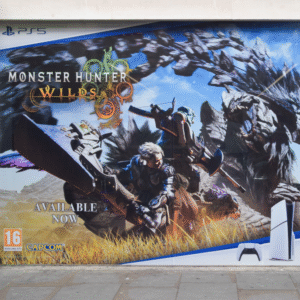17-year-old Sofiia Didenko discusses the unaffordability of gaming for Gen Z

A billboard for the game Monster Hunter Wilds outside the offices of PlayStation UK in London.
Picture by: Vuk Valcic | ZUMA Press, Inc. | Alamy
Article link copied.
Have you noticed that the price of video games and related equipment continues to rise? Recently, I was browsing Steam, an online gaming platform, and the brand-new Monster Hunter Wilds caught my eye, but, oh no – it costs a whopping $70. I guess I’ll have to settle for something older and cheaper.
Overall consumer spending on video games in the United States totalled $57.2bn in 2023, according to data from the Entertainment Software Association. As a gamer, I know how painful it is to spend huge amounts of money on my favourite pastime.
Harbingers’ Weekly Brief
Gaming as a hobby is becoming too expensive for the average teenager.
For example, the Nintendo Switch 2 that came out in June costs $450. For comparison, the regular Nintendo Switch costs around $300.
It is important to note that the changes between the two models are minimal, the only significant one being that the Switch 2 is slightly bigger than its predecessor. Even so, the battery life of the newer model is reported to be shorter than in the regular console.
And that’s without counting the prices of games, which average $60–$80 each. Legend of Zelda: Tears of the Kingdom, for example, comes with a price tag of $65.
This shows how the cost of video game-related hobbies is rising, as well as a wider concern about the general availability of affordable hobbies in the future. Huge gaming companies, such as Nintendo and Dungeons & Dragons, are seemingly cashing in on elder millennials and Gen X who have stable incomes and are inclined to spend lots of money on hobbies – Gen Z and younger millennials, not so much.
Why did I bring up Dungeons & Dragons in the argument? It’s simple. The price of D&D sourcebooks has increased by 20%, bumping the average price for a physical edition of a printed handbook to almost $70 – seemingly for no apparent reason.
One could argue that with increasing inflation and the rise of new technologies the prices can be explained and even excused, that Gen Z should manage their finances better in order to be able to afford more things. But if all the companies in the entertainment industry raise their prices, then what can consumers really do? Maybe switch to other types of entertainment, such as movies?
Numerous streaming apps offer collections of movies and series to watch for a fixed price per month, such as Netflix, HBO Max and many more. It is stated that on average, people in the US pay $61 per month on streamingacross an average of four services a month, while 88% of households have at least one video streaming subscription.
Let’s say you pay for Netflix only. But then, hey, HBO Max filmed a series based on your favourite comic, so now you have to get a subscription for it as well. A year later, you are reminded of your favourite childhood show, but it is only available on Disney+ – so you start paying for that as well.
Even if most subscriptions offer a free trial or are cancellable, many times you find yourself too lazy to do so, or just forget about cancelling it.
If this example demonstrates how much you need to spend to just enjoy movies, then imagine how much more expensive it is with video games. It is possible that the prices on pastimes will continue to rise – unless we do something about it.
Do you want to collect Pokémon cards again, just for your pleasure and not for chasing the card with the most monetary value? Then we better start thinking of solutions to this crisis, before it gets worse.
Written by:

Contributor
Denia, Spain
Born in 2007 in Kyiv, Sofiia studies in Benitachell, Spain. She is interested in business studies, particularly marketing and plans to study at Geneva Business School in Barcelona. For Harbingers’ Magazine, she writes about gaming and books.
In her free time, Sofiia enjoys video games, reads dystopian fiction, and spends time with her dog. She also was a part of a debating team in Ukraine and won the best speaker award at the Dnipro Open Debating Tournament in 2022.
Sofiia speaks Ukrainian, English, Russian, French, and a bit of Spanish.
Edited by:

🌍 Join the World's Youngest Newsroom—Create a Free Account
Sign up to save your favourite articles, get personalised recommendations, and stay informed about stories that Gen Z worldwide actually care about. Plus, subscribe to our newsletter for the latest stories delivered straight to your inbox. 📲
© 2025 The Oxford School for the Future of Journalism


